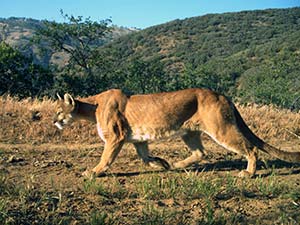
Contact Us
Institutional Communications
Bureau of Mines Building, Room 137
Laramie, WY 82071
Phone: (307) 766-2929
Email: cbaldwin@uwyo.edu
UW Researchers Hone Computer Models to Identify Animals in Photos
Published July 18, 2023

This camera-trap image of a mountain lion was among those used to train computer models
to identify animals with a high degree of accuracy and efficiency. (Jim Beasley Photo)
University of Wyoming researchers once again have advanced artificial intelligence technology to identify images of wild animals from camera-trap photographs in North America.
The researchers used 3 million camera-trap images from 18 studies in 10 U.S. states to develop two computer models that demonstrated remarkable accuracy and efficiency in accomplishing a task that is important in wildlife research.
The project, detailed in an article in the journal Ecology and Evolution, makes the technology more accessible to biologists who do not have advanced computational skills. It builds on previous research that shows the artificial intelligence technique called deep learning can take the place of slow, tedious analysis of individual photos by people.
“Training a model that can be used to classify species in multiple environments is tricky,” says Mikey Tabak, an adjunct faculty member in UW’s Department of Zoology and Physiology, and a recent UW Ph.D. graduate. “But we found that training modules with many species from multiple locations improved our ability to classify species in new environments.”
Tabak is the lead author of the paper, which also received contributions from recent UW computer science Ph.D. graduate Mohammad Sadegh (Arash) Norouzzadeh and former UW Department of Computer Science faculty member Jeff Clune.
The models were developed using camera-trap images from California, Colorado, Florida, Idaho, Minnesota, Montana, South Carolina, Texas, Washington and Wisconsin. The first one, called the “species model,” recognizes 58 species, ranging from snowshoe hares to grizzly bears. The second, called the “empty-animal model,” effectively filters out images that do not contain animals -- an important function in analyzing large numbers of camera-trap photos.
Both models were 97 percent accurate when tested with images from the areas from which the software was developed. When tested with images from other parts of the world, the empty-animal model’s accuracy ranged from 90 percent-94 percent. The species model was less accurate, ranging from 65 percent-93 percent.
“The poor performance of the species model in some areas indicates that some users will need to train new models on images from their field sites,” Tabak says. “But the empty-animal model appears to be broadly applicable for sorting out empty images in datasets globally. By first removing the empty images, users can focus on those with animals and more easily label a large enough dataset to train models.”
The researchers have made the new models freely available in a software package in Program R. The package allows other users to classify their images containing the 58 species in the dataset, but it also allows users to train their own machine-learning models using images from new datasets in a point-and-click interface through a package called Shiny.
“Our R Shiny apps allow ecologists with minimal programming experience to train deep learning models specific to their own field sites, which will hopefully save time and money in many wildlife camera-trap projects,” Tabak says.
Contact Us
Institutional Communications
Bureau of Mines Building, Room 137
Laramie, WY 82071
Phone: (307) 766-2929
Email: cbaldwin@uwyo.edu
